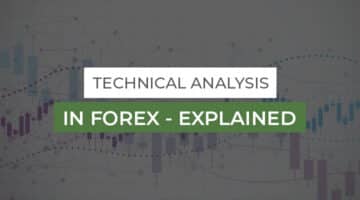Different Types of Moving Averages

In this article
Moving averages can be defined to smooth out price fluctuations to help you distinguish between typical market noise and the actual trend direction.
Moving Averages are a trend-following or lagging indicator. It is based on past prices.
The longer the period is for the moving average, the greater the lag will be. It is why a 200-day moving average will have a much greater market noise than a 20-day MA because it includes the prices for the past 200 days.
There are many types of moving averages. Each creates a line on a chart that helps in showing in which direction a price is moving.
In this guide, we will find out the different types of moving averages in forex trading.
1. Simple Moving Average
The simplest type of moving average is the simple moving average (SMA).
The simple moving average computes an average of the last n prices, where Px is the price in a period and n is the number of periods as you are not using all of the data, the average moves. You are just using the recent periods.
The formula for calculating SMA is:
SMA = (P1 + P2 + P3 + P4 +……Px )/n
As a trader, if you plotted a four-period simple moving average on a 30-minute chart, you add up the closing prices for the last 2 hours. The next step is to divide the number by 4.
Now, you have the average closing price over the last five hours. Now you need to string those average prices together, and you get a moving average.
Although it is helpful to know how to calculate the moving average, trading and chart platforms already get the job done.
You apply the SMA indicator to the chart after selecting it from the list of charting indicators. Following that, you can change the number of periods you want to use.
The benefit of using an SMA is that you are aware of what you are getting yourself into. The SMA value is equal to the average price for the number of periods used in the SMA computation.
Traders often utilised SMAs of nine, twenty, fifty, one hundred, and two hundred periods. If you use a 100-period SMA, the current value of the SMA on the chart represents the average price for the last 100 periods or price bars.
2. Exponential Moving Average
This moving average is a type of moving average that gives more weight to the recent prices.
For example, if a four-period EMA has 1.4555, 1.4556, 1.4557, and 1.4558, then the last value is the most recent and gives a current EMA value of 1.4557.
The EMA is more adaptable to price changes as compared to the SMA. If a price reverses direction, the EMA will reverse direction more rapidly than the SMA because the EMA formula gives more weightage to the recent prices and less weight to past prices.
With the SMA, the charting platforms do all EMA calculations for you. On a charting platform, select the EMA from the indicator list and apply it to your chart. Enter the options and change the number of periods the indicator should calculate to 15, 50, or 100.
3. Weighted Moving Average
WMA returns a weighted average of recent prices, with the weight decreasing with each prior price. The WMA is close to the EMA, but it must be calculated differently.
WMAs can have different weights based on the number of periods used in the calculation. If you wish to calculate a weighted moving average of four separate prices, the most recent weighing maybe 4 to 10. The prior period could be worth 3 to 10 points. The third phase could be weighted from 2 to 10.
A weight of 4 to 10 means that you have ten recent periods and their prices. You choose the four most current prices. It accounts for 40% of the value of the WMA. The cost four periods ago only accounts for 10% of the WMA value.
The weighted moving average can be customised more than the SMA and EMA. Typically, the most recent pricing points are given more weight. It might also work the other way around, where past pricing is given more weight.
How to use different types of moving averages?
One clever use of moving averages is to assist you in determining the trend.
The simplest method is to simply draw a single moving average on the chart.
When price movement tends to stay above the moving average, it indicates that the market is on an uptrend.
Price action that tends to stay below the moving average implies that the market is in a downturn.
When the price crosses over its moving average, it is becoming more effective compared to where it was previously because the most recent price is now greater than the average. If the price falls below its moving average, it is deteriorating compared to where it was previously.
For instance, you can add 20 and 50 periods MAs to a chart together.
When the 20-period moving average crosses over the 50-period moving average, it implies that short-term price momentum is trending upward. When the 20-period MA crosses below the 50-period moving average, it indicates that short-term market momentum is shifting to the downside.
You may find that you need to alter your settings somewhat for each market. A 50-period SMA, for example, may produce excellent signals on one forex pair but not on another. Similarly, a 20-period EMA may assist in isolating the trend on one pair but not on another.
All moving averages are only tools, and how they are interpreted is up to the trader because no indication works perfectly all of the time or in all market conditions.
Summary for moving averages
One type of moving average isn’t better than another. They calculate the average price in different ways. Depending on the trading methodology, one type of moving average may perform better than another. Experiment with various moving average combinations to find which produces the best results.
Jason Morgan is an experienced forex analyst and writer with a deep understanding of the financial markets. With over 13+ years of industry experience, he has honed his skills in analyzing and forecasting currency movements, providing valuable insights to traders and investors.
Forex Content Writer | Market Analyst
Relevant Posts
4 Tips for Choosing a Forex Broker
If you are a trader in the Forex or foreign exchange market, then there is…
Read more

What is a Margin Call?
[top_three_brokers] The traders need to know about margin calls, how they arrive, and avoid them…
Read more
Forex Trading Volumes – What Is It And How To Use Them
[top_three_brokers] The abbreviation VSA stands for Volume Spread Analysis — the analysis of changes in…
Read more

Heiken Ashi Indicator Explained
[top_three_brokers] Do you know what the Heikin Ashi technique is all about and for what…
Read more

Line Graph Explained
[top_three_brokers] In forex trading, there are different types of charts that help you visualise price…
Read more

Forex Tick Volume Explained
[top_three_brokers] Forex trading is all about volume. Financial institutions, banks, retail traders all make the…
Read more

Best Trading Platforms Reviewed
[top_three_brokers] Naturally, many traders are interested in learning about the best trading platform. One of…
Read more

Forex Continuation Patterns
[top_three_brokers] The trading world is all about anticipating what's going to happen. Then, based on…
Read more

What is a Forex Broker, and what Services do they offer?
[top_three_brokers] The forex market is the most liquid market in the world, with an average…
Read more

What is Technical Analysis in Forex – Explained
[top_three_brokers] The most common question that pops up in a new trader head is, "what…
Read more
4 Tips for Choosing a Forex Broker
If you are a trader in the Forex or foreign exchange market, then there is…

What is a Margin Call?
[top_three_brokers] The traders need to know about margin calls, how they arrive, and avoid them…
Forex Trading Volumes – What Is It And How To Use Them
[top_three_brokers] The abbreviation VSA stands for Volume Spread Analysis — the analysis of changes in…

Heiken Ashi Indicator Explained
[top_three_brokers] Do you know what the Heikin Ashi technique is all about and for what…

Line Graph Explained
[top_three_brokers] In forex trading, there are different types of charts that help you visualise price…

Forex Tick Volume Explained
[top_three_brokers] Forex trading is all about volume. Financial institutions, banks, retail traders all make the…

Best Trading Platforms Reviewed
[top_three_brokers] Naturally, many traders are interested in learning about the best trading platform. One of…

Forex Continuation Patterns
[top_three_brokers] The trading world is all about anticipating what's going to happen. Then, based on…

What is a Forex Broker, and what Services do they offer?
[top_three_brokers] The forex market is the most liquid market in the world, with an average…

What is Technical Analysis in Forex – Explained
[top_three_brokers] The most common question that pops up in a new trader head is, "what…


